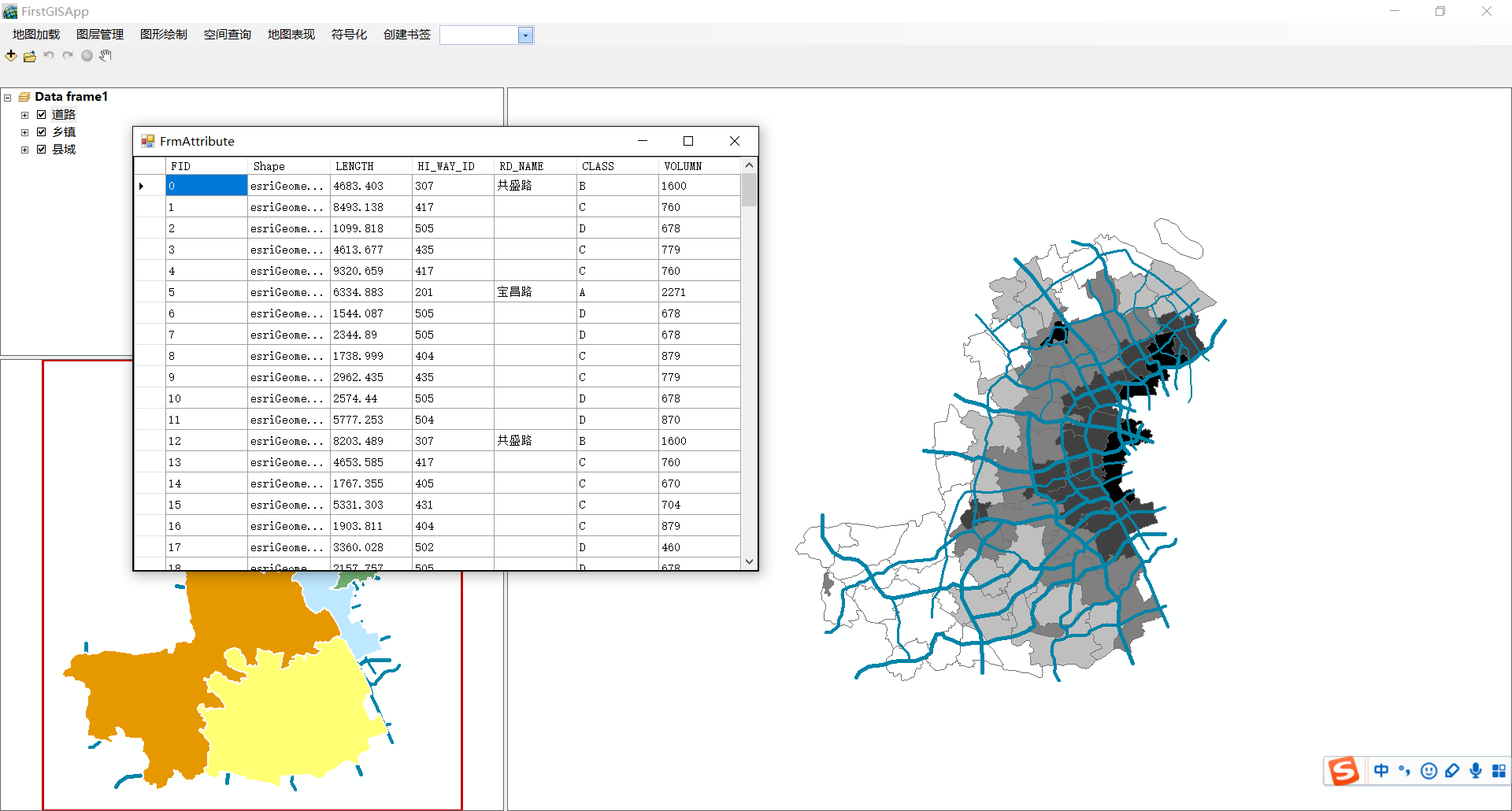这是我设计的主窗体

新建一个窗体,拖入一个datagridview控件,用来展示图层属性,Dock属性设为Fill

在主窗体中设置一个OnMouseDown事件
private void axTOCControl1_OnMouseDown ( object sender, ITOCControlEvents_OnMouseDownEvent e ) { //鼠标右键 if (e.button == 2) { esriTOCControlItem Item = new esriTOCControlItem(); IBasicMap pMap = new MapClass(); ILayer pLayer = new FeatureLayerClass(); object pOther = new object(); object pIndex = new object(); //获取鼠标点击的图层,通过ref参数返回点击位置所关联的图层 this.axTOCControl1.HitTest( e.x, e.y, ref Item, ref pMap, ref pLayer, ref pOther, ref pIndex ); IMapControl2 pMapControl = (IMapControl2)axMapControl1.Object; IFeatureLayer pFeatureLayer = pLayer as IFeatureLayer; FrmAttribute pFemAttribute = new FrmAttribute( pMapControl, pFeatureLayer.Name ); pFemAttribute.ShowDialog(); } }
以下是属性展示窗体的源代码,其中包括了全屏显示属性、datagridview自适应form宽度、在表中点击字段名在主窗体中高亮显示等功能
namespace GIS3._6 { public partial class FrmAttribute : Form { public FrmAttribute ( ) { InitializeComponent(); } int width = 0; public IMapControl2 pMapControl; public IMap pMap; public int LayerIndex; public string LayerName; public FrmAttribute ( IMapControl2 pMapControl, string LyrName ) { InitializeComponent(); this.pMapControl = pMapControl; pMap = pMapControl.Map; LayerName = LyrName; } private void FrmAttribute_Load ( object sender, EventArgs e ) { GetValues(); #region datagridview自适应form for (int i = 0 ; i < this.dataGridView1.Columns.Count ; i++) { //将每一列都调整为自动适应模式 //this.dataGridView1.AutoResizeColumn( DataGridViewAutoSizeColumnMode.AllCells); //记录整个DataGridView的宽度 width += this.dataGridView1.Columns[i].Width; } if (width > this.dataGridView1.Size.Width) { this.dataGridView1.AutoSizeColumnsMode = DataGridViewAutoSizeColumnsMode.DisplayedCells; } else { this.dataGridView1.AutoSizeColumnsMode = DataGridViewAutoSizeColumnsMode.Fill; } //冻结某列 从左开始 0,1,2 dataGridView1.Columns[1].Frozen = true; #endregion } #region 枚举 public enum DataGridViewAutoSizeColumnMode { NotSet = 0, None = 1, ColumnHeader = 2, AllCellsExceptHeader = 4, AllCells = 6, DisplayedCellsExceptHeader = 8, DisplayedCells = 10, Fill = 16, } #endregion public void GetValues ( ) { for (int i = 0 ; i < pMap.LayerCount ; i++) { if (LayerName == pMap.get_Layer( i ).Name) { LayerIndex = i; break; } } IFeatureLayer pFeatureLayer = pMap.get_Layer( LayerIndex ) as IFeatureLayer; IFields pFields = pFeatureLayer.FeatureClass.Fields; dataGridView1.ColumnCount = pFields.FieldCount; for (int i = 0 ; i < pFields.FieldCount ; i++) { string fieldname; fieldname = pFields.get_Field( i ).Name; dataGridView1.Columns[i].Name = fieldname; } IFeatureCursor pFeatureCursor = pFeatureLayer.FeatureClass.Search( null, false ); IFeature pFeature = pFeatureCursor.NextFeature(); while (pFeature != null) { //pFields.FieldCount 总字段数 string[] fldvalue = new string[pFields.FieldCount]; for (int i = 0 ; i < pFields.FieldCount ; i++) { if (pFields.get_Field( i ).Name == "Shape") { fldvalue[i] = Convert.ToString( pFeature.Shape.GeometryType ); } else { fldvalue[i] = Convert.ToString( pFeature.get_Value( i ) ); } } dataGridView1.Rows.Add( fldvalue ); pFeature = pFeatureCursor.NextFeature(); } } private void dataGridView1_CellContentClick ( object sender, DataGridViewCellEventArgs e ) { } #region 双击表内容在屏幕居中展示所选要素 private void dataGridView1_CellDoubleClick ( object sender, DataGridViewCellEventArgs e ) { string FID; FID = dataGridView1.Rows[e.RowIndex].Cells[0].Value.ToString(); if (FID == "") return; IActiveView pActiveView; pActiveView = (IActiveView)pMap; pMap.ClearSelection(); pActiveView.Refresh(); IQueryFilter pQueryFilter = new QueryFilterClass(); pQueryFilter.WhereClause = "FID=" + FID; IFeatureLayer pFeatureLayer; pFeatureLayer = (IFeatureLayer)pMap.get_Layer( LayerIndex ); IFeatureCursor pFeatureCursor; pFeatureCursor = pFeatureLayer.Search( pQueryFilter, false ); IFeature pFeature; pFeature = pFeatureCursor.NextFeature(); pMap.SelectFeature( pFeatureLayer, pFeature ); IPoint pPoint = new PointClass(); pPoint.X = ( pFeature.Extent.XMin + pFeature.Extent.XMax ) / 2; pPoint.Y = ( pFeature.Extent.YMin + pFeature.Extent.YMax ) / 2; pMapControl.CenterAt( pPoint ); pActiveView.PartialRefresh( esriViewDrawPhase.esriViewGeoSelection, null, null ); } #endregion } }
以下是运行效果,通过鼠标右键TOC中的图层名直接弹出属性查看窗体

目前正在写一个只显示指定图层的指定属性的功能
